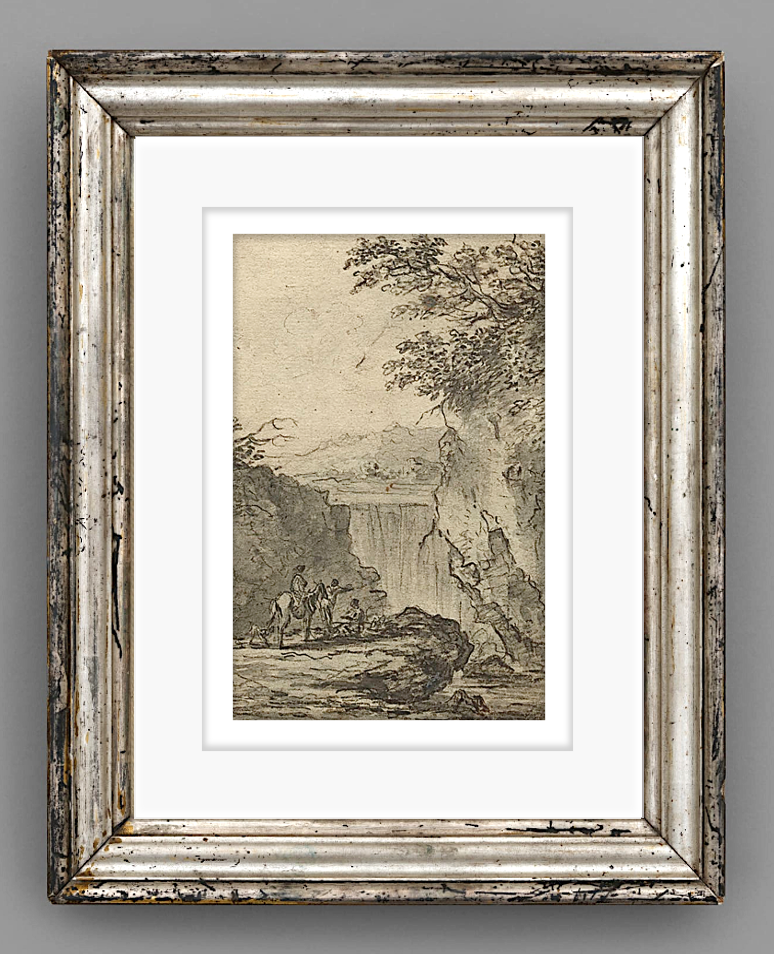

Title: Travelers Resting near a Waterfall By Artist Jean Pierre Norblain
Shipping: $49.00
Artist: N/A
Period: 18th Century
History: N/A
Origin: N/A
Condition: Very Good
Item Date: 1745 - 1830
Item ID: 6610
Attributed to the artist Jean Pierre Norblain (France, 1745 - 1830) Travelers Resting near a Waterfall. Gray ink wash and black chalk on cream laid paper. Unsigned. Framed under plexi, overall 17 ⅛" x 14 ⅛". Very good. Glued to the bluish grey wove paper along the perimeter with open back. Several minor brown spots. Small hole in the middle of upper half. Stains, pencil inscriptions and signs of older drawing verso. Born in Misy-sur-Yonne in 1740. Norblin started his career in France, in the early sixties (his first known works date to 1763). Later he became influenced by Rembrandt and Watteau. Around 1769 he trained in the studio of Francesco Casanova, then around 1769–70 at the Académie Royale de Peinture et de Sculpture, and in 1770–71 under Louis-Michel van Loo and Joseph-Marie Vien at the Ecole Royale des Elèves Protégés, all in Paris. Around 1771–72 he worked in Paris, London, Dresden and Spa, and possibly studied for a time under Christian Wilhelm Ernst Dietrich. In 1772 he met Polish Prince Adam Kazimierz Czartoryski, with whom he traveled for two years and by whom he was invited to Poland. From 1774 he worked for the magnate family of Czartoryski and became their court artist and tutor for the children. Among his early works the most prominent are his illustrations to Myszeida, a poem by Ignacy Krasicki. He worked in Puławy and at Powązki estates as painter and decorator of local Czartoryski's estates. Later he also worked for the Radziwiłł family in Arkadia (Nieborów) and for King Stanisław August Poniatowski. In 1790 settled in Warsaw where he established his art school, and this move allowed him to witness and illustrate many important historical moments of the last years of the Polish-Lithuanian Commonwealth. His hurriedly sketched drawings illustrated the passing of the Constitution of the 3 May and soon he became famous as the eye-witness and painter-chronicler of the Kościuszko Uprising, immortalising many of the most famous events of that event in his paintings: from the Warsaw Uprising in April and the consequent hanging of Targowica traitors in the Old Market Square, through the battle of Racławice to Massacre of Praga. After his return to France in 1804 he still continued to paint based on some of his Poland-era drafts, but he also illustrated other contemporary events, among them the times of the Napoleon's wars. He died in Paris in 1830. Norblin's students in Poland included Aleksander Orłowski, Michał Płoński and Jan Rustem. Jean-Pierre Norblin de La Gourdaine was the great-grandfather of an equally accomplished artist, Stefan Norblin (full name: Juliusz Stefan Norblin de la Gourdaine; Warsaw, 29 June 1892 – 12 August 1952, San Francisco, California). The paintings of Stefan Norblin, who worked in Poland, India (during World War II) and the United States, were rediscovered in the 1990s in India, where they decorate maharajas' palaces, e.g., in Rajasthan. The first exhibition of his works in postwar Poland took place at the Regional Museum in Stalowa Wola, 3 September – 9 October 2011. *Our job is to find and target great art by collecting a vast array of contemporary, vintage, antique and collectible items from across the globe. Individually handcrafted, we breathe new life into these forgotten relics by giving back each piece it's unique story. We welcome dealers, galleries, and private collectors to register securely and buy with us.
Link: https://en.wikipedia.org/wiki/Jean-Pierre_Norblin_de_La_Gourdaine
Jean-Pierre Norblin de La Gourdaine (in Polish, Jan Piotr Norblin; 15 July 1745 – 23 February 1830) was a French-born painter, draughtsman, engraver, drawing artist and caricaturist. From 1774 to 1804 he resided in the Polish-Lithuanian Commonwealth, where he obtained citizenship.
He is considered one of the most important painters of the Polish Enlightenment. He achieved great success in Poland. Given many commissions from some of the most notable families of the Polish-Lithuanian Commonwealth, he stayed there for many years, not returning to Paris until the early 19th century. His style showed the influence of Antoine Watteau, and combined the Rococo tradition of charming fêtes galantes and fêtes champêtres with a panorama of daily life and current political events, captured with journalistic accuracy. He created a gallery of portraits of representatives of all social classes in the last years of the Polish-Lithuanian Commonwealth.